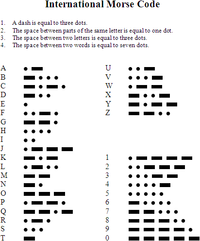Morse code: Difference between revisions
From Halopedia, the Halo wiki
Halopediaman (talk | contribs) mNo edit summary |
|||
| Line 15: | Line 15: | ||
Morse code can be transmitted in a number of ways: originally as electrical pulses along a telegraph wire, but also as an audio tone, a radio signal with short and long tones, or as a mechanical or visual signal (e.g. a flashing light) using devices like an Aldis lamp or a heliograph. Morse code is transmitted using just two states (on and off) so it was an early form of a digital code. However, it is technically not binary, as the pause lengths are required to decode the information. | Morse code can be transmitted in a number of ways: originally as electrical pulses along a telegraph wire, but also as an audio tone, a radio signal with short and long tones, or as a mechanical or visual signal (e.g. a flashing light) using devices like an Aldis lamp or a heliograph. Morse code is transmitted using just two states (on and off) so it was an early form of a digital code. However, it is technically not binary, as the pause lengths are required to decode the information. | ||
Morse Code is apparently still one of many different codes still in use with the [[UNSC]] by at least [[2552]].<ref>''[[Halo: First Strike]]'', | Morse Code is apparently still one of many different codes still in use with the [[UNSC]] by at least [[2552]].<ref>'''[[Halo: First Strike]]''', ''page 156''</ref> It can also be heard on a radio on [[High Ground (Level)|High Ground]], spelling out "Frog Blast The Vent Core".<ref>'''[[Halo 3]]''', multiplayer level, ''[[High Ground (Level)]]''</ref> | ||
== Trivia == | == Trivia == | ||
Revision as of 01:18, January 22, 2011
Template:Ratings Template:SeeWikipedia
Morse Code is a character encoding for transmitting telegraphic information, using standardized sequences of short and long elements to represent the letters, numerals, punctuation and special characters of a given message. The short and long elements can be formed by sounds, marks or pulses, in on off keying and are commonly known as "dots" and "dashes" or "dits" and "dahs".
International Morse code is composed of five elements:
- short mark, dot or 'dit' (·) — one unit long
- longer mark, dash or 'dah' (–) — three units long
- intra-character gap (between the dots and dashes within a character) — one unit long
- short gap (between letters) — three units long
- medium gap (between words) — seven units long
Morse code can be transmitted in a number of ways: originally as electrical pulses along a telegraph wire, but also as an audio tone, a radio signal with short and long tones, or as a mechanical or visual signal (e.g. a flashing light) using devices like an Aldis lamp or a heliograph. Morse code is transmitted using just two states (on and off) so it was an early form of a digital code. However, it is technically not binary, as the pause lengths are required to decode the information.
Morse Code is apparently still one of many different codes still in use with the UNSC by at least 2552.[1] It can also be heard on a radio on High Ground, spelling out "Frog Blast The Vent Core".[2]
Trivia
- Morse code was used in the Red vs. Blue episode "An Audience of Dumb" when the evil A.I., O'Malley, was dying. He transmitted C-O-C-K-B-I-T-E-S as he was disappearing, but ceased when Doc activated his radio. O'Malley possessed Doc while he was trying to contact Blue Command.
Sources
- ^ Halo: First Strike, page 156
- ^ Halo 3, multiplayer level, High Ground (Level)
